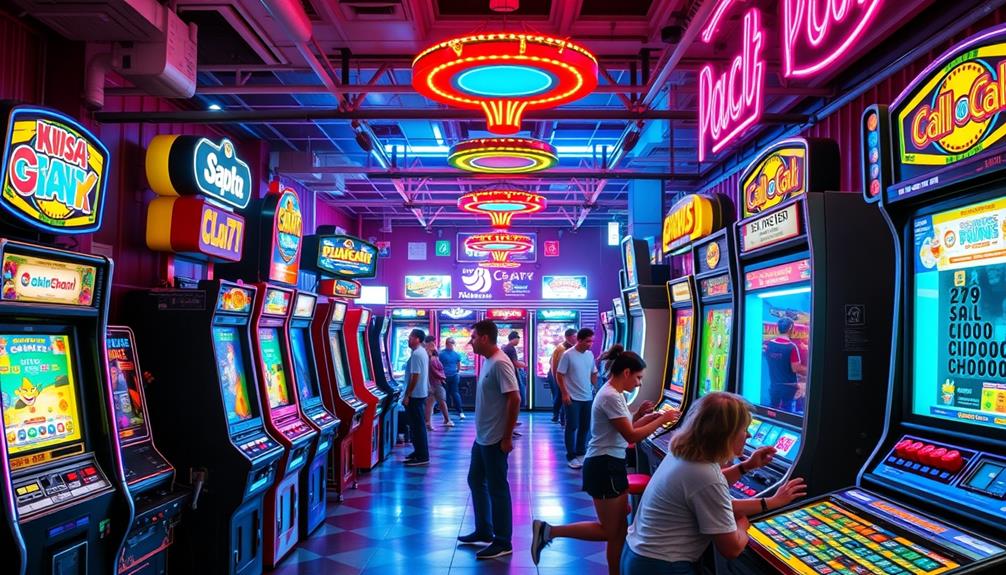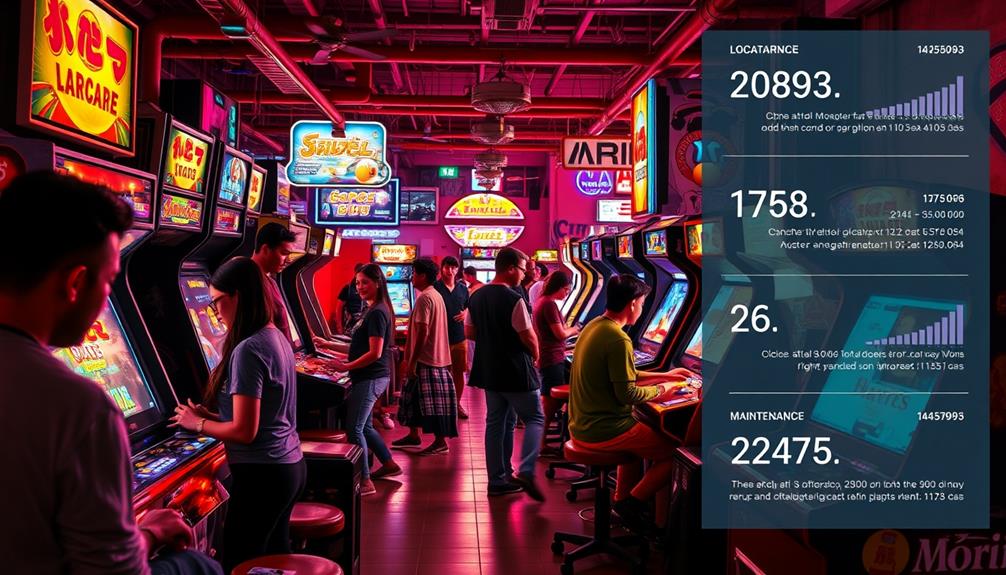Arcade games can be profitable if you manage them wisely. With an initial investment typically below $300,000 for small arcades, your earnings primarily come from play fees, ranging from $0.25 to $2.00. Smaller venues might see around $5,000 monthly, while premium spots can hit up to $40,000. Understanding your customer base is essential; teenagers and young adults often spend $10 to $25 per visit. By focusing on popular game types like redemption games, you can boost your profit margins. There are many factors that influence success, and exploring these can enhance your strategy.
Key Takeaways
- Arcade games can be profitable, with gross margins between 25% and 45%, and net margins averaging 5% to 15%.
- Revenue primarily comes from play fees, which can range from $0.25 to $2.00 per game.
- Redemption arcade systems boost repeat business, enticing customers to spend more on prizes and in-arcade purchases.
- The location significantly impacts profitability, with urban arcades potentially generating up to $20,000 monthly.
- A balanced game mix, focusing on 60-70% redemption games, enhances overall profitability and customer engagement.
Arcade Business Start-Up Costs
Starting an arcade can be an exciting venture, but you'll need to navigate significant start-up costs from the get-go. Your initial investment typically averages below $300,000 for a small arcade, while larger venues can exceed millions. One of your biggest expenses will be game acquisition, which often makes up over half of your total budget. Choosing the right games is essential to attract customer traffic and guarantee satisfaction, especially when contemplating options like the best arcade machines for home game rooms that can appeal to a wide audience.
Ongoing maintenance is another important aspect of your operational costs. You'll need to evaluate utilities, staff salaries, and routine maintenance to keep everything running smoothly. The average monthly costs can reach around $15,000, so developing a solid business strategy is fundamental to achieve profitability.
Securing funding through loans, grants, or investors is critical to cover these initial start-up costs, as well as to sustain operations in the long run. Additionally, think about your entertainment options and how they'll create diverse revenue streams.
Revenue Models in Arcade Games

Arcade games can be a lucrative business, primarily generating income through play fees that typically range from $0.25 to $2.00 per game. The revenue from arcade operations can vary widely; small arcades might earn around $5,000 monthly, while premium venues can rake in up to $40,000, depending on game diversity and services offered.
Additionally, the charm and allure of the arcade atmosphere can enhance customer experience and draw in crowds, much like how astrology influences attractiveness in social settings.
One effective model is the redemption arcade system, which encourages repeat business by allowing customers to exchange game plays for tickets that can be redeemed for prizes. This not only boosts spending but also enhances customer loyalty.
Profit margins for arcade games are impressive, with gross margins between 25% and 45%, and net margins averaging 5% to 15%. This underscores the significance of cost management and careful game selection to maximize profitability.
Additionally, understanding seasonal trends is vital. Earnings tend to spike during weekends and holidays, making strategic game placement and promotional events necessary for maximizing revenue potential.
Customer Demographics and Spending

When it comes to customer demographics in arcades, teenagers and young adults dominate the scene, making up the primary audience that fuels spending. This group, typically aged 13 to 30, engages enthusiastically with arcade games, often spending between $10 to $25 per visit. Such spending contributes considerably to the overall revenue generation for arcades.
Incorporating unique party options can also attract this demographic, enhancing their overall entertainment experience.
You'll find that these customers visit arcades around 3 to 8 times a month, reflecting a strong potential for repeat business. Their loyalty enhances the customer lifetime value, which averages between $120 and $800 per individual. This long-term revenue potential is essential for sustaining arcade operations.
In addition to arcade games, spending often includes in-arcade purchases like snacks and drinks, further boosting revenue.
Prize redemption systems also play a considerable role, enticing customers to spend more in hopes of winning a coveted item. By understanding these dynamics, you can see why targeting teenagers and young adults is key to creating a compelling entertainment experience that keeps them coming back for more.
Key Factors Influencing Profitability

Profitability in the arcade industry hinges on several key factors that directly impact revenue generation and sustainability. Game selection is essential; focusing on redemption games can yield a payout around 30%, while video games and skill-based machines may generate lower returns. A balanced game mix, ideally 60-70% redemption games, 20-30% video games, and 10-15% merchandisers, can optimize profitability.
Additionally, understanding your budget and tracking expenses can provide insights into operational costs and help you allocate resources effectively in your arcade business, leading to better financial management and overall success in the industry common financial terms and jargon.
Your arcade's location also plays a significant role. Urban arcades might pull in monthly revenues of up to $20,000, while rural spots average around $5,000. A solid business plan that considers these dynamics can set your arcade up for success.
Ongoing maintenance is another important factor. Regular upkeep prevents game breakdowns and guarantees you maximize revenue during peak times. Quick repairs also help maintain customer satisfaction, which is essential for repeat visits.
Customer demographics and average customer spending—ranging from $10 to $25 per visit—should guide your strategy. Engaging a diverse audience can enhance revenue generation, making it imperative to understand who your customers are and what they enjoy.
Future Trends in Arcade Gaming

As the arcade industry evolves, staying ahead of future trends can greatly impact your success. The U.S. arcade market is on track to grow at a CAGR of 8.2% from 2023 to 2028, indicating a strong resurgence in interest and profitability. To maximize your revenue potential, consider integrating new games to keep your audience engaged and exploring entertainment options beyond traditional gaming. Innovations like VR experiences, interactive multiplayer setups, and skill-based redemption games are driving much of this growth, making it essential to continually update your offerings. Introducing new arcade games in 2023 is an excellent strategy to attract both loyal customers and curious newcomers looking for fresh experiences. Additionally, fostering a community-focused environment with themed events or tournaments can further boost customer retention and differentiate your arcade from competitors.
| Trend | Impact on Profitability |
|---|---|
| Nostalgic-driven bars | Attract diverse audiences |
| Virtual reality experiences | Appeal to tech-savvy consumers |
| Innovative dining options | Enhance overall revenue potential |
| Immersive gaming tech | Drive high ROI opportunities |
The rise of nostalgic-driven arcade bars blends retro and modern gaming experiences, giving you a unique market edge. By embracing innovative gaming technology, you can create highly profitable environments for family entertainment. As the projected revenue hits approximately $5.48 million by 2030, adapting to these trends is essential for your arcade's growth and success.
Frequently Asked Questions
Are Arcade Games a Good Investment?
If you're considering arcade games as an investment, you'll want to research machine types and locations. Popular machines can yield solid profits, especially with proper maintenance and strategic selection, increasing your chances for success.
Are Arcade Games Still Profitable?
Imagine stepping into a vibrant world of flashing lights and laughter. Yes, arcade games are still profitable, drawing crowds with engaging experiences, while modern redemption systems guarantee you'll keep customers coming back for more fun.
What Is the Profit Margin on Arcade Games?
The profit margin on arcade games typically ranges from 25% to 45%, depending on the game type. By choosing popular games and managing costs effectively, you can maximize your profits and enhance overall earnings. In addition to selecting the right games, it’s important to understand and leverage various arcade game revenue models. These can include pay-per-play, memberships or subscriptions, and even in-game advertising. By diversifying your revenue streams and constantly evaluating your business model, you can ensure a steady flow of income and continued success in the arcade industry. Another important factor to consider when maximizing profits in the arcade industry is the location of your arcade. High foot traffic areas with a large target demographic can greatly impact the earning potential of arcade games. It’s also crucial to keep up with industry trends and technology advancements to keep your arcade competitive and appealing to customers. By staying informed and adapting to changes in the market, you can further boost the earning potential of arcade games and increase your overall profitability.
Do Arcade Machines Make Money?
You might be surprised to know that arcade machines can really rack up some cash! Depending on the type and location, you can see weekly earnings ranging from $100 to over $1,000. It's quite enticing!
Conclusion
In the ever-evolving world of arcade gaming, your venture can thrive like a phoenix rising from the ashes of nostalgia. By understanding the costs, revenue models, and customer preferences, you can access the treasure chest of profitability. Keep an eye on emerging trends, and don't hesitate to adapt—like a chameleon in a colorful world. With dedication and a dash of creativity, your arcade can become the go-to spot for fun, ensuring you reap the rewards of your investment.









